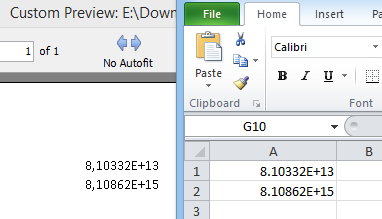I still don't see it. You spoke about different numbers:
8,10861515062236 E15 instead of 81033172103352
But I see both Excel and FlexCel have 8108615150622360 in either your screenshot or mine.
For the rest, 8,10861515062236 E15 is the same as 8108615150622360, those are 2 representations for the same value, so I am not sure on what the error is?
GetStringFromCell in FlexCel will return a string that shows the number as Excel would show it. In this case, it returns:
And this is also what Excel shows in the cell (see the first screenshot), so GetStringFromCell is working fine.
GetCellValue will return a floating point number, which is 8108615150622360
Now, this is floating point number, it isn't a string, and you can represent it as 8.1E15 or 8...<15 0s>
You can represent it in a string in many ways. By default, Delphi "StringToFloat" will convert very big numbers to exponential notation, and smaller numbers to normal notation.
But you can change how the string is converted. For example:
showmessage(FloatToStr(xls.GetCellValue(2, 1).AsNumber));
will be converted to
since this is the default Delphi representation for big numbers. On the other hand, if you explicitly say you want a "fixed" notation:
showmessage(FloatToStrF(xls.GetCellValue(2, 1).AsNumber, ffFixed, 18, 0));
This will show:
Both numbers are the same, just shown in different representations.
Can it be that you are confusing by the way Delphi converts numbers by default? I mean, if you write (no FlexCel at all):
showmessage(FloatToStr(81033172103352));
showmessage(FloatToStr(8108615150622360));
You'll see the results are:
And this is ok, since when you use a "general" formatting, FloatToString uses ffGeneral, which will use the format it believes is best for the number.
The "ToString()" in "GetCellValue(...).ToString() just uses FloatToString under the hood, so it behaves the same way.
Just in case, this are the different possibilities (from delphi help):
|
ffGeneral
|
General number format. The value is converted to the shortest possible
decimal string using scientific format. Trailing zeros are removed from the
resulting string.
|
|
ffExponent
|
Scientific format. The value is converted to a string of the form
"-d.ddd...E+dddd". The resulting string starts with a minus sign if the number
is negative, and one digit always precedes the decimal point. The total number
of digits before the exponent in the resulting string (including the one before
the decimal point) is given by the Precision parameter. The "E" exponent
character in the resulting string is always followed by a plus or minus sign and
up to four digits. The Digits parameter specifies the minimum number of digits
in the exponent (between 0 and 4).
|
|
ffFixed
|
Fixed point format. The value is converted to a string of the form
"-ddd.ddd...". The resulting string starts with a minus sign if the number is
negative, and at least one digit always precedes the decimal point. The number
of digits after the decimal point is given by the Digits parameter--it must be
between 0 and 18. If the number of digits to the left of the decimal point is
greater than the specified precision, the resulting value will use scientific
format. The resulting values is padded with zeros when the Digits parameter is
higher than the number of digits dictated by precision. For example, given
ffFixed with Precision set to 5 and digits set to 3, fomatting 345.6789 gives
the string '345.680', padding with zeros after the precision is met.
|
|
ffNumber
|
Number format. The value is converted to a string of the form
"-d,ddd,ddd.ddd...". The ffNumber format corresponds to the ffFixed format,
except that the resulting string contains thousandth separators. The resulting
value is padded with zeros when the Digits parameter is higher than the number
of digits dictated by precision. For example, given ffNumber with Precision set
to 5 and digits set to 3, fomatting 345.6789 gives the string '345.680', padding
with zeros after the precision is met.
|
|
ffCurrency
|
Currency format. The value is converted to a string that represents a
currency amount. The conversion is controlled by the CurrencyString, CurrencyFormat, NegCurrFormat, ThousandSeparator, and DecimalSeparator global
variables, all of which are initialized from Currency Format in the International section of
the Windows Control Panel. The number of digits after the decimal point is given
by the Digits parameter--it must be between 0 and 18. The resulting value is
padded with zeros when the Digits parameter is higher than the number of digits
dictated by precision. For example, given ffCurrency with Precision set to 5 and
digits set to 3, fomatting 345.6789 gives the string '345.680', padding with
zeros after the precision is met.
|
